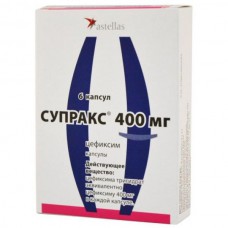Expiration date: 11/2025
Composition and form of issue:
Capsules. 1 capsule contains:
cefixim 200 mg or 400 mg
excipients: silicon dioxide colloidal magnesium stearate carboxymethyl cellulose azorubin
capsule shell composition: titanium dioxide dyes-d&C yellow 10, FD & C yellow 6, Indigo Carmine, FD & C blue gelatin
in contour cell pack 6 PCs. in a pack of cardboard 1 package.
Granules for preparation of suspension for oral administration. 5 ml contains:
cefixime 100 mg
auxiliary substances: sodium benzoate, sucrose resin yellow flavor strawberry
in dark glass bottles of 60 ml in a cardboard pack 1 bottle complete with dosing spoon.
Description of dosage form:
Capsules of 200 mg with a yellow lid and white body, containing a mixture of powder and fine granules of yellowish-white color.
Capsules of 400 mg with violet lid and white body, containing a mixture of powder and fine granules of yellowish-white color. Per capsule coded N808.
Granules for the preparation of suspensions for oral administration: small granules from white to cream color. After breeding-suspension from almost white to cream color with a sweet aroma of strawberries.
Characteristic:
Semi-synthetic cephalosporin antibiotic of third generation for oral administration.
Pharmacokinetics:
When ingestion bioavailability of cefixime is 40-50% regardless of the meal, but Cmax cefixime in serum is achieved by 0, 8 h faster when taking the drug with food.
When taking the drug in the form of capsules at a dose of 200 mg Cmax serum is achieved through 4 h and is 2 mkg/ ml, when taken at a dose of 400 mg-3, 5 mkg/ml.when taking the drug in the form of a suspension at a dose of 200 mg Cmax serum is achieved through 4 h and is 2, 8 mkg/ml, when taken at a dose of 400 mg — 4, 4 mkg / ml. Binding to plasma proteins, mainly albumins, is 65%.
About 50% of the dose is excreted in the urine unchanged for 24 hours, about 10% of the dose is excreted in the bile. T1 / 2 depends on the dose and is 3-4 hours.
In patients with renal impairment Cl creatinine 20-40 ml / min T1 / 2 increases to 6, 4 h, Cl creatinine 5-10 ml — min - to 11, 5 h.
Description of the pharmacological action:
Inhibits the synthesis of the cell membrane of the pathogen. Cefixim is resistant to beta-lactamases produced by most gram-positive and gram-negative bacteria.
In vitro cefixime is active against gram-positive bacteria: Streptococcus agalactiae gram-negative bacteria: Haemophilus parainfluenzae, Proteus vulgaris, Klebsiella pneumoniae, Klebsiella oxytoca, Pasteurella multocida, Providencia spp., Salmonella spp., Shigella spp., Citrobacter amalonaticus, Citrobacter diversus, Serratia marcescens.
In vitro and in clinical practice cefixime active against gram-positive bacteria: Streptococcus pneumoniae, Streptococcus pyogenes gram-negative bacteria: Haemophilus influenzae, Moraxella (Branhamella) catarrhalis, E. coli, Proteus mirabilis, Neisseria gonorrhoeae.
The drug is resistant Pseudomonas spp., Enterococcus (Streptococcus) serogroups D, Listeria monocytogenes, most Staphylococcus spp. ( including methicillin-resistant strains), Enterobacter spp., Bacteroides fragilis, Clostridium spp.
Indications:
Infectious and inflammatory diseases caused by microorganisms sensitive to the drug:
- pharyngitis, tonsillitis, sinusitis
- acute and chronic bronchitis
- otitis media
- uncomplicated urinary tract infections
- uncomplicated gonorrhea.
Contraindications:
- Hypersensitivity to cephalosporins and penicillins.
With caution:
- old age
- chronic renal failure
- pseudomembranous colitis (history)
- children's age (up to 6 months).
Application for pregnancy and breastfeeding:
Application of pregnancy is possible only in the case when expected benefit for mother exceeds the potential risk to the fetus.
If necessary, use during lactation should stop breastfeeding.
Side effect:
Allergic reactions: urticaria, hyperemia of the skin, itching, eosinophilia, fever.
From the digestive system: dry mouth, anorexia, nausea, vomiting, diarrhea, flatulence, abdominal pain, dysbacteriosis, liver dysfunction (increased activity of hepatic transaminases, schf, hyperbilirubinemia, jaundice), gastrointestinal candidiasis rarely — stomatitis, glossitis, pseudomembranous enterocolitis.
From the hematopoietic organs: leukopenia, neutropenia, thrombocytopenia, hemolytic anemia.
From the urinary system: interstitial nephritis.
From the nervous system: dizziness, headache.
Drug interaction:
Blockers of tubular secretion (allopurinol, diuretics, etc.) delay the excretion of cefixim by kidneys, which can lead to an increase in toxicity.
Reduces prothrombin index, increases the effect of indirect anticoagulants.
Antacids containing magnesium or aluminum hydroxide, slow absorption of the drug.
Method of application and doses:
Inside. For adults and children over 12 years weighing more than 50 kg average daily dose — 400 mg (1 time per day or 200 mg twice a day). The average duration of treatment is 7-10 days.
With uncomplicated gonorrhea-400 mg 1 time per day.
Children under the age of 12 years appointed as a suspension in a dose of 8 mg/kg once or in 2 admission (4 mg/kg every 12 h). For children aged 6 months to 1 year, the daily dose of the suspension-2, 5-4 ml, at the age of 2-4 years-5 ml, at the age of 5-11 years — 6-10 ml.in diseases caused by Streptococcus pyogenes, the course of treatment — at least 10 days.
In violation of kidney function dose is set depending on the index of creatinine clearance in the blood serum: in Cl creatinine 21-60 ml/min or in patients on hemodialysis, the daily dose should be reduced by 25%. At Cl creatinine less than or equal to 20 ml / min or in patients on peritoneal dialysis, the daily dose should be reduced by 2 times.
The method of preparation of the suspension: turn the bottle and shake the powder. Add 40 ml chilled to room temperature boiled water in 2 stages and shake after each addition until homogeneous suspension. After that, it is necessary to allow the suspension to settle for 5 minutes to ensure complete dissolution of the powder. Before use, the finished suspension should be shaken.
Overdose:
Symptoms: increased risk of adverse reactions.
Treatment: gastric lavage, symptomatic and supportive therapy that includes the use of antihistamines, corticosteroids, Pressor amines, oxygen therapy, transfusion, infusion solutions, artificial lung ventilation. It is not excreted in significant amounts by hemo - or peritoneal dialysis.
Special instruction:
Patients who have a history of allergic reactions to penicillins may have an increased sensitivity to cephalosporin antibiotics.
In the long admission preparation possible violation of normal intestinal microflora, which can lead to the growth of Clostridium difficile, can cause severe diarrhoea and pseudomembranous colitis.
During treatment is positive direct response Kumbsa and lozhnopolojitelnaya reaction of urine for glucose.


